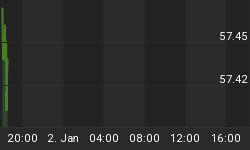Fed Changed Market's Tone

The financial markets watch the Fed very closely, and for good reason as outlined on October 25. Wednesday's Fed statement was interpreted by the markets as being more hawkish than expected (hawks want higher rates/low inflation). Investors were hoping for a "the economy is worse than we thought, due in part to the government shutdown" statement. Instead, the Fed stated downside risks to the outlook for the economy and the labor market as having diminished.
Manufacturing Supported Hawkish Stance
The Fed desperately wants to wind down their money printing and bond buying campaign known as QE. A strengthening economy gives the Fed more ammunition to try to convince the markets that tapering will not be the end of civilization as we know it. Friday's ISM number supported a more hawkish stance from the Fed. From MarketWatch:
U.S. manufacturing remained strong in October, according to a closely followed index released Friday. The Institute for Supply Management's manufacturing index climbed to 56.4% -- the highest level since April 2011 -- from 56.2% in September. Economists polled by MarketWatch expected a 55% reading, and any reading over 50% indicates expansion. Both the new orders and production indexes have registered above 60% for three consecutive months.
Bullard Offsets Fed Statement

The Fed wants to keep the markets guessing. Why? If they all were singing from the "we are going to taper soon" hymnal, then interest rates would spike in a systemically unsettling manner. Friday the markets were told the Fed has some leeway to print more money if needed. From MarketWatch:
Bullard told reporters that the central bank has "breathing room" on the size of its balance sheet and noted that other central banks have larger balance sheets relative to the size of their economies. The St. Louis Fed president devoted most of his speech to the disconnect between the market and the Fed over monetary policy. Fed officials think that tapering should be separate from its forward guidance over the timing of the first rate hike. The market clearly links the two together, he said. Bullard said the Fed needs either to convince markets that the two policy tools are distinct or "learn to live with the joint effects of tapering on both the pace of asset purchases and the perception of future policy rates."
Fear Is Deflationary
Common sense tells us when the demand for stocks is greater than the demand for bonds, the aggregate economic outlook of all market participants is "net bullish." Conversely, when the demand for conservative bonds is greater than the demand for growth-oriented stocks, the aggregate economic outlook of all market participants is "net bearish." Stocks go up under net-bullish conditions. Stocks go down under net-bearish conditions. Why do we care about aggregate demand? It determines the value of our investments as outlined in You Will Never Look At The Markets The Same Way Again.
The 2011 chart below shows the demand for bonds (AGG) relative to stocks (SPY). When the ratio rises, it tells us the demand for economic fear is greater than the demand for economic confidence. Investors want bonds when they are fearful; they prefer stocks when they are confident. Notice the ratio below began to rise in favor of fear three months before the stock market peaked in 2011.

How Does The Same Fear Gauge Look Now?
Even with some defensive cracks appearing in the bullish case over the past two weeks, bonds clearly remain in a downtrend relative to the S&P 500. For us to become more concerned and to make the stock market bears happier, the chart below needs to flip from a bearish trend to a bullish trend.

Investment Implications - Evidence Not Bearish At This Time
A fair counter-argument is the Fed has been manipulating the bond market for years and investors are nervous about a spike in interest rates. That's true, but if rising rates or tapering causes harm to the economy and/or stock market, we would still expect to see stocks drop more than bonds. Remember on a relative chart, such as AGG/SPY, the ratio can rise when both stocks and bonds are falling if bonds are falling less. That is not what we have right now. Therefore, until the market's pricing mechanism shows the aggregate opinion has shifted in favor of deflationary and risk-off assets (bonds, inverse stocks, CDs, etc), we will continue to hold our risk-on allocation. We have concerns about the market's indecisive behavior, but the concerns have not produced enough observable evidence in our market model to warrant changes to our portfolio, which includes U.S. exposure (SPY), technology (QQQ), foreign stocks (EFA), and global stocks (VT).
















